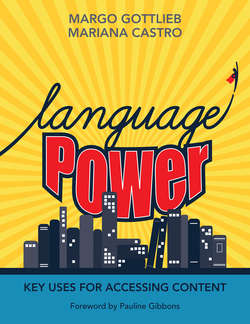Читать книгу Language Power - Margo Gottlieb - Страница 21
На сайте Литреса книга снята с продажи.
Teaching and Learning Theory
ОглавлениеFor a long time, language has been recognized as a vehicle for learning (Dewey, 1916; Vygotsky, 1934/1962). The ways in which language is used by students, teachers, and families have an impact on how children learn. Some researchers, for example, have attributed how well students do in school to the particular language patterns used by the social groups to which they belong (Bernstein, 1970; Brice-Heath, 1983). These studies highlight the unique ways in which language is used in school and the need to socialize children into those ways so that they can be successful. In spite of the existing research on the critical role that language plays in school, language development has not been fully integrated into the learning taking place in our classrooms.
Many of our current teaching approaches come from sociocultural theory, which sees learning as a social activity. This theory proposes that learning happens through social interaction, with assistance from teachers and peers who are more knowledgeable, and as they engage in culturally meaningful tasks (Vygotsky, 1978). In this social and interactive perspective, language plays a central role; it is a tool for negotiating meaning, for problem solving, and for making sense of the world, individually and with others. Language is not seen as an abstract system of linguistic forms or an individual form of activity, but instead, it is a continuous generative process that is learned through dialogue (Bakhtin, 1986). This dialogue takes place within particular social contexts and cultures that impact the ways in which people use languages (Martin, Christie, & Rothery, 1994).
For example, the ways one uses language when writing an e-mail, when filling out an application, or when producing a book report are very different. Because of the many contexts, thinking about goals or purposes for language use without a framework can become overwhelming. Key uses of academic language afford us the opportunity to focus and organize teaching and learning in a more manageable manner and, at the same time, to better and more purposefully integrate language and content instruction.
In sum, learning theory highlights the important role of language for students to be able to access and achieve content-related ideas and concepts. Further, since learning is social in nature and not an individual endeavor, language provides opportunities for students to engage meaningfully with others in learning activities. A focus on key uses of academic language ensures that all students possess the means to be able to internalize and share what they learn in school.
Take the DARE
Throughout the book, we challenge you to take the DARE by posing questions, providing activities, and offering resources for you to reflect on in each section. Whether you are reading this book on your own or with colleagues, each activity is aimed at helping you identify ways to focus on academic language use in your practice.
As an example, in this section, we ask you to engage in deep reflection about language by answering the following questions:
1 How do you define academic language use?
2 What is your teaching and learning philosophy? Does it include academic language use? If so, how? If not, how might you include it?
3 What common beliefs about academic language development do you share with colleagues?
4 What role do you believe academic language use has in teaching and learning?
5 How do you include discussions about language use in your classroom or promote them in your school?
